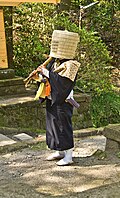Kinko Kurosawa
This article needs additional citations for verification. (March 2023) |
| Part of a series on |
| Komusō |
|---|
 |
| People |
|
| Philosophy |
| Places |
|
| Topics |
| Literature |
|
Kinko Kurosawa (黒沢 琴古, Kurosawa Kinko) was an 18th-century komusō of the Fuke sect of Zen Buddhism. A former samurai, he became a shakuhachi instructor and founded the Kinko-Ryu (ja) school of shakuhachi.[1]
Commissioned to travel around Japan to research and collect spiritual shakuhachi music pieces (honkyoku) from his fellow mendicant monks, Kurosawa is credited with helping shakuhachi music transition from a solely spiritual tool into music appreciated by a secular audience through his selection of 36 honkyoku chosen to form the shakuhachi repertoire of the Kinko-Ryu school to be played by its priests.[2]
Legacy[edit]
The Kurosawa crater on the planet Mercury is named for Kinko Kurosawa.[3]
Shika No Tone (Distant Calls of Deer), a honkyoku arranged by Kurosawa, is featured on the Memoirs of a Geisha soundtrack.[4]
References[edit]
- ^ Seiyu, Hélène (16 January 2017). "Kinko-Ryu Honkyoku". hijirishakuhachi.com.
- ^ "Shakuhachi is Japan's traditional bamboo flute instrument". japanese-music.com.
- ^ "Kurosawa". Gazetteer of Planetary Nomenclature. NASA. Retrieved 12 October 2022.
- ^ "Kinko Kurosawa". IMDb.
